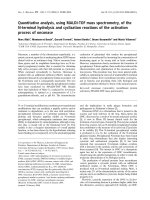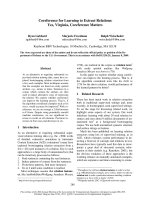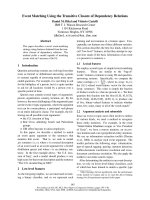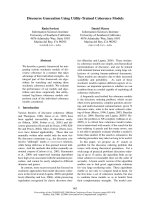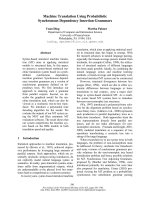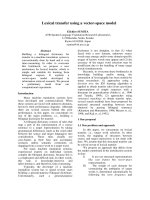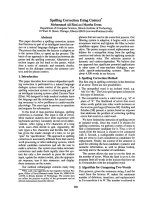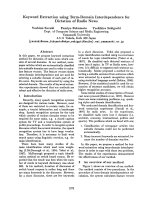Báo cáo khoa học: "Coreference Resolution Using Competition Learning Approach" docx
Bạn đang xem bản rút gọn của tài liệu. Xem và tải ngay bản đầy đủ của tài liệu tại đây (198.03 KB, 8 trang )
Coreference Resolution Using Competition Learning Approach
Xiaofeng Yang
*+
Guodong Zhou
*
Jian Su
*
Chew Lim Tan
+
*Institute for Infocomm Research,
21 Heng Mui Keng Terrace,
Singapore 119613
+
Department of Computer Science,
National University of Singapore,
Singapore 117543
*
{xiaofengy,zhougd,sujian}@
i2r.a-star.edu.sg
+
(yangxiao,tancl)@comp.nus.edu.sg
Abstract
In this paper we propose a competition
learning approach to coreference resolu-
tion. Traditionally, supervised machine
learning approaches adopt the single-
candidate model. Nevertheless the prefer-
ence relationship between the antecedent
candidates cannot be determined accu-
rately in this model. By contrast, our ap-
proach adopts a twin-candidate learning
model. Such a model can present the
competition criterion for antecedent can-
didates reliably, and ensure that the most
preferred candidate is selected. Further-
more, our approach applies a candidate
filter to reduce the computational cost and
data noises during training and resolution.
The experimental results on MUC-6 and
MUC-7 data set show that our approach
can outperform those based on the single-
candidate model.
1 Introduction
Coreference resolution is the process of linking
together multiple expressions of a given entity. The
key to solve this problem is to determine the ante-
cedent for each referring expression in a document.
In coreference resolution, it is common that two
or more candidates compete to be the antecedent of
an anaphor (Mitkov, 1999). Whether a candidate is
coreferential to an anaphor is often determined by
the competition among all the candidates. So far,
various algorithms have been proposed to deter-
mine the preference relationship between two can-
didates. Mitkov’s knowledge-poor pronoun
resolution method (Mitkov, 1998), for example,
uses the scores from a set of antecedent indicators
to rank the candidates. And centering algorithms
(Brennan et al., 1987; Strube, 1998; Tetreault,
2001), sort the antecedent candidates based on the
ranking of the forward-looking or backward-
looking centers.
In recent years, supervised machine learning
approaches have been widely used in coreference
resolution (Aone and Bennett, 1995; McCarthy,
1996; Soon et al., 2001; Ng and Cardie, 2002a),
and have achieved significant success. Normally,
these approaches adopt a single-candidate model in
which the classifier judges whether an antecedent
candidate is coreferential to an anaphor with a con-
fidence value. The confidence values are generally
used as the competition criterion for the antecedent
candidates. For example, the “Best-First” selection
algorithms (Aone and Bennett, 1995; Ng and
Cardie, 2002a) link the anaphor to the candidate
with the maximal confidence value (above 0.5).
One problem of the single-candidate model,
however, is that it only takes into account the rela-
tionships between an anaphor and one individual
candidate at a time, and overlooks the preference
relationship between candidates. Consequently, the
confidence values cannot accurately represent the
true competition criterion for the candidates.
In this paper, we present a competition learning
approach to coreference resolution. Motivated by
the research work by Connolly et al. (1997), our
approach adopts a twin-candidate model to directly
learn the competition criterion for the antecedent
candidates. In such a model, a classifier is trained
based on the instances formed by an anaphor and a
pair of its antecedent candidates. The classifier is
then used to determine the preference between any
two candidates of an anaphor encountered in a new
document. The candidate that wins the most com-
parisons is selected as the antecedent. In order to
reduce the computational cost and data noises, our
approach also employs a candidate filter to elimi-
nate the invalid or irrelevant candidates.
The layout of this paper is as follows. Section 2
briefly describes the single-candidate model and
analyzes its limitation. Section 3 proposes in de-
tails the twin-candidate model and Section 4 pre-
sents our coreference resolution approach based on
this model. Section 5 reports and discusses the ex-
perimental results. Section 6 describes related re-
search work. Finally, conclusion is given in
Section 7.
2 The Single-Candidate Model
The main idea of the single-candidate model for
coreference resolution is to recast the resolution as
a binary classification problem.
During training, a set of training instances is
generated for each anaphor in an annotated text.
An instance is formed by the anaphor and one of
its antecedent candidates. It is labeled as positive
or negative based on whether or not the candidate
is tagged in the same coreferential chain of the
anaphor.
After training, a classifier is ready to resolve the
NPs
1
encountered in a new document. For each NP
under consideration, every one of its antecedent
candidates is paired with it to form a test instance.
The classifier returns a number between 0 and 1
that indicates the likelihood that the candidate is
coreferential to the NP.
The returned confidence value is commonly
used as the competition criterion to rank the candi-
date. Normally, the candidates with confidences
less than a selection threshold (e.g. 0.5) are dis-
carded. Then some algorithms are applied to
choose one of the remaining candidates, if any, as
the antecedent. For example, “Closest-First” (Soon
et al., 2001) selects the candidate closest to the
anaphor, while “Best-First” (Aone and Bennett,
1995; Ng and Cardie, 2002a) selects the candidate
with the maximal confidence value.
One limitation of this model, however, is that it
only considers the relationships between a NP en-
countered and one of its candidates at a time dur-
ing its training and testing procedures. The
confidence value reflects the probability that the
candidate is coreferential to the NP in the overall
1
In this paper a NP corresponds to a Markable in MUC
coreference resolution tasks.
distribution
2
, but not the conditional probability
when the candidate is concurrent with other com-
petitors. Consequently, the confidence values are
unreliable to represent the true competition crite-
rion for the candidates.
To illustrate this problem, just suppose a data
set where an instance could be described with four
exclusive features: F1, F2, F3 and F4. The ranking
of candidates obeys the following rule:
CS
F1
>> CS
F2
>> CS
F3
>> CS
F4
Here CS
Fi
(
41
≤
≤
i
) is the set of antecedent can-
didates with the feature Fi on. The mark of “>>”
denotes the preference relationship, that is, the
candidates in CS
F1
is preferred to those in CS
F2
, and
to those in CS
F3
and CS
F4
.
Let CF
2
and CF
3
denote the class value of a leaf
node “F2 = 1” and “F3 = 1”, respectively. It is pos-
sible that CF
2
< CF
3
, if the anaphors whose candi-
dates all belong to CS
F3
or CS
F4
take the majority in
the training data set. In this case, a candidate in
CS
F3
would be assigned a larger confidence value
than a candidate in CS
F2
. This nevertheless contra-
dicts the ranking rules. If during resolution, the
candidates of an anaphor all come from CS
F2
or
CS
F3
, the anaphor may be wrongly linked to a can-
didate in CS
F3
rather than in CS
F2
.
3 The Twin-Candidate Model
Different from the single-candidate model, the
twin-candidate model aims to learn the competition
criterion for candidates. In this section, we will
introduce the structure of the model in details.
3.1 Training Instances Creation
Consider an anaphor ana and its candidate set can-
didate_set, {C
1
, C
2
, …, C
k
}, where C
j
is closer to
ana than C
i
if j > i. Suppose positive_set is the set
of candidates that occur in the coreferential chain
of ana, and negative_set is the set of candidates not
in the chain, that is, negative_set = candidate_set
- positive_set. The set of training instances based
on ana, inst_set, is defined as follows:
2
Suppose we use C4.5 algorithm and the class value takes the
smoothed ration,
2
1
+
+
t
p
, where p is the number of positive
instances and t is the total number of instances contained in
the corresponding leaf node.
} _ C , _Cj,i |{
} _ C ,_ C j,i |{
_
ji),,(
ji),,(
setpositvesetnegativeinst
setnegativesetpositveinst
s
e
t
inst
anaCjCi
anaCjCi
∈∈>
∈∈>
=
U
From the above definition, an instance is
formed by an anaphor, one positive candidate and
one negative candidate. For each instance,
)ana,cj,ci(inst , the candidate at the first position, C
i
,
is closer to the anaphor than the candidate at the
second position, C
j
.
A training instance
)ana,cj,ci(inst is labeled as
positive if C
i
∈ positive-set and C
j
∈ negative-set;
or negative if C
i
∈
negative-set and C
j
∈
positive-
set.
See the following example:
Any design to link China's accession to the WTO
with the missile tests
1
was doomed to failure.
“If some countries
2
try to block China TO acces-
sion, that will not be popular and will fail to win the
support of other countries
3
” she said.
Although no governments
4
have suggested formal
sanctions
5
on China over the missile tests
6
, the United
States has called them
7
“provocative and reckless” and
other countries said they could threaten Asian stability.
In the above text segment, the antecedent can-
didate set of the pronoun “them
7
” consists of six
candidates highlighted in Italics. Among the can-
didates, Candidate 1 and 6 are in the coreferential
chain of “them
7
”, while Candidate 2, 3, 4, 5 are not.
Thus, eight instances are formed for “them
7
”:
(2,1,7) (3,1,7) (4,1,7) (5,1,7)
(6,5,7) (6,4,7) (6,3,7) (6,2,7)
Here the instances in the first line are negative,
while those in the second line are all positive.
3.2 Features Definition
A feature vector is specified for each training or
testing instance. Similar to those in the single-
candidate model, the features may describe the
lexical, syntactic, semantic and positional relation-
ships of an anaphor and any one of its candidates.
Besides, the feature set may also contain inter-
candidate features characterizing the relationships
between the pair of candidates, e.g. the distance
between the candidates in the number distances or
paragraphs.
3.3 Classifier Generation
Based on the feature vectors generated for each
anaphor encountered in the training data set, a
classifier can be trained using a certain machine
learning algorithm, such as C4.5, RIPPER, etc.
Given the feature vector of a test instance
)ana,cj,ci(inst (i > j), the classifier returns the posi-
tive class indicating that C
i
is preferred to C
j
as the
antecedent of ana; or negative indicating that C
j
is
preferred.
3.4 Antecedent Identification
Let CR(
)ana,cj,ci(inst ) denote the classification re-
sult for an instance
)ana,cj,ci(inst . The antecedent of
an anaphor is identified using the algorithm shown
in Figure 1.
Algorithm
ANTE-SEL
Input: ana: the anaphor under consideration
candidate_set: the set of antecedent can-
didates of ana, {C
1
, C
2
,…,C
k
}
for
i = 1
to
K
do
Score[ i ] = 0;
for
i = K
downto
2
do
for
j = i – 1
downto
1
do
if
CR(
)ana,cj,ci(inst ) = = positive
then
Score[ i ]++;
else
Score[ j ] ++;
endif
SelectedIdx=
][maxarg
_
iScore
setcandidateCi
i
∈
return C
selectedIdx
;
Figure 1:The antecedent identification algorithm
Algorithm ANTE-SEL takes as input an ana-
phor and its candidate set candidate_set, and re-
turns one candidate as its antecedent. In the
algorithm, each candidate is compared against any
other candidate. The classifier acts as a judge dur-
ing each comparison. The score of each candidate
increases by one every time when it wins. In this
way, the final score of a candidate records the total
times it wins. The candidate with the maximal
score is singled out as the antecedent.
If two or more candidates have the same maxi-
mal score, the one closest to the anaphor would be
selected.
3.5 Single-Candidate Model: A Special Case
of Twin-Candidate Model?
While the realization and the structure of the twin-
candidate model are significantly different from
the single-candidate model, the single-candidate
model in fact can be regarded as a special case of
the twin-candidate model.
To illustrate this, just consider a virtual “blank”
candidate C
0
such that we could convert an in-
stance
)ana,ci(inst
in the single-candidate model to
an instance
)ana,c,ci( 0inst in the twin-candidate
model. Let
)ana,c,ci( 0inst have the same class label
as
)ana,ci(inst , that is, )ana,c,ci( 0inst is positive if C
i
is
the antecedent of ana; or negative if not.
Apparently, the classifier trained on the in-
stance set {
)ana,ci(inst
}, T1, is equivalent to that
trained on {
)ana,c,ci( 0inst }, T2. T1 and T2 would
assign the same class label for the test instances
)ana,ci(inst and )ana,c,ci( 0inst , respectively. That is to
say, determining whether C
i
is coreferential to ana
by T1 in the single-candidate model equals to
determining whether C
i
is better than C
0
w.r.t ana
by T2 in the twin-candidate model. Here we could
take C
0
as a “standard candidate”.
While the classification in the single-candidate
model can find its interpretation in the twin-
candidate model, it is not true vice versa. Conse-
quently, we can safely draw the conclusion that the
twin-candidate model is more powerful than the
single-candidate model in characterizing the rela-
tionships among an anaphor and its candidates.
4 The Competition Learning Approach
Our competition learning approach adopts the
twin-candidate model introduced in the Section 3.
The main process of the approach is as follows:
1. The raw input documents are preprocessed to
obtain most, if not all, of the possible NPs.
2. During training, for each anaphoric NP, we
create a set of candidates, and then generate
the training instances as described in Section 3.
3. Based on the training instances, we make use
of the C5.0 learning algorithm (Quinlan, 1993)
to train a classifier.
4. During resolution, for each NP encountered,
we also construct a candidate set. If the set is
empty, we left this NP unresolved; otherwise
we apply the antecedent identification algo-
rithm to choose the antecedent and then link
the NP to it.
4.1 Preprocessing
To determine the boundary of the noun phrases, a
pipeline of Nature Language Processing compo-
nents are applied to an input raw text:
Tokenization and sentence segmentation
Named entity recognition
Part-of-speech tagging
Noun phrase chunking
Among them, named entity recognition, part-of-
speech tagging and text chunking apply the same
Hidden Markov Model (HMM) based engine with
error-driven learning capability (Zhou and Su,
2000 & 2002). The named entity recognition
component recognizes various types of MUC-style
named entities, i.e., organization, location, person,
date, time, money and percentage.
4.2 Features Selection
For our study, in this paper we only select those
features that can be obtained with low annotation
cost and high reliability. All features are listed in
Table 1 together with their respective possible val-
ues.
4.3 Candidates Filtering
For a NP under consideration, all of its preceding
NPs could be the antecedent candidates. Neverthe-
less, since in the twin-candidate model the number
of instances for a given anaphor is about the square
of the number of its antecedent candidates, the
computational cost would be prohibitively large if
we include all the NPs in the candidate set. More-
over, many of the preceding NPs are irrelevant or
even invalid with regard to the anaphor. These data
noises may hamper the training of a good-
performanced classifier, and also damage the accu-
racy of the antecedent selection: too many com-
parisons are made between incorrect candidates.
Therefore, in order to reduce the computational
cost and data noises, an effective candidate filter-
ing strategy must be applied in our approach.
During training, we create the candidate set for
each anaphor with the following filtering algorithm:
1. If the anaphor is a pronoun,
(a) Add to the initial candidate set all the pre-
ceding NPs in the current and the previous
two sentences.
(b) Remove from the candidate set those that
disagree in number, gender, and person.
(c) If the candidate set is empty, add the NPs in
an earlier sentence and go to 1(b).
2. If the anaphor is a non-pronoun,
(a) Add all the non-pronominal antecedents to
the initial candidate set.
(b) For each candidate added in 2(a), add the
non-pronouns in the current, the previous
and the next sentences into the candidate set.
During resolution, we filter the candidates for
each encountered pronoun in the same way as dur-
ing training. That is, we only consider the NPs in
the current and the preceding 2 sentences. Such a
context window is reasonable as the distance be-
tween a pronominal anaphor and its antecedent is
generally short. In the MUC-6 data set, for exam-
ple, the immediate antecedents of 95% pronominal
anaphors can be found within the above distance.
Comparatively, candidate filtering for non-
pronouns during resolution is complicated. A po-
tential problem is that for each non-pronoun under
consideration, the twin-candidate model always
chooses a candidate as the antecedent, even though
all of the candidates are “low-qualified”, that is,
unlikely to be coreferential to the non-pronoun un-
der consideration.
In fact, the twin-candidate model in itself can
identify the qualification of a candidate. We can
compare every candidate with a virtual “standard
candidate”, C
0
. Only those better than C
0
are
deemed qualified and allowed to enter the “round
robin”, whereas the losers are eliminated. As we
have discussed in Section 3.5, the classifier on the
pairs of a candidate and C
0
is just a single-
candidate classifier. Thus, we can safely adopt the
single-candidate classifier as our candidate filter.
The candidate filtering algorithm during resolu-
tion is as follows:
Features describing the candidate
:
1.
2.
3.
4.
5.
6.
7.
8.
9.
10
ante_DefNp_1(2)
ante_IndefNP_1(2)
ante_Pron_1(2)
ante_ProperNP_1(2)
ante_M_ProperNP_1(2)
ante_ProperNP_APPOS_1(2)
ante_Appositive_1(2)
ante_NearestNP_1(2)
ante_Embeded_1(2)
ante_Title_1(2)
1 if C
i
(C
j
) is a definite NP; else 0
1 if C
i
(C
j
) is an indefinite NP; else 0
1 if C
i
(C
j
) is a pronoun; else 0
1 if C
i
(C
j
) is a proper NP; else 0
1 if C
i
(C
j
) is a mentioned proper NP; else 0
1 if C
i
(C
j
) is a proper NP modified by an appositive; else 0
1 if C
i
(C
j
) is in a apposition structure; else 0
1 if C
i
(C
j
) is the nearest candidate to the anaphor; else 0
1 if C
i
(C
j
) is in an embedded NP; else 0
1 if C
i
(C
j
) is in a title; else 0
Features describing the anaphor:
11.
12.
13.
14.
15.
16.
ana_DefNP
ana_IndefNP
ana_Pron
ana_ProperNP
ana_PronType
ana_FlexiblePron
1 if ana is a definite NP; else 0
1 if ana is an indefinite NP; else 0
1 if ana is a pronoun; else 0
1 if ana is a proper NP; else 0
1 if ana is a third person pronoun; 2 if a single neuter pro-
noun; 3 if a plural neuter pronoun; 4 if other types
1 if ana is a flexible pronoun; else 0
Features describing the candidate and the anaphor:
17.
18.
18.
20.
21.
ante_ana_StringMatch_1(2)
ante_ana_GenderAgree_1(2)
ante_ana_NumAgree_1(2)
ante_ana_Appositive_1(2)
ante_ana_Alias_1(2)
1 if C
i
(C
j
) and ana match in string; else 0
1 if C
i
(C
j
) and ana agree in gender; else 0 if disagree; -1 if
unknown
1 if C
i
(C
j
) and ana agree in number; 0 if disagree; -1 if un-
known
1 if C
i
(C
j
) and ana are in an appositive structure; else 0
1 if C
i
(C
j
) and ana are in an alias of the other; else 0
Features describing the two candidates
22.
23.
inter_SDistance
inter_Pdistance
Distance between C
i
and C
j
in sentences
Distance between C
i
and C
j
in paragraphs
Table 1: Feature set for coreference resolution (Feature 22, 23 and features involving C
j
are not
used in the single-candidate model)
1. If the current NP is a pronoun, construct the
candidate set in the same way as during training.
2. If the current NP is a non-pronoun,
(a) Add all the preceding non-pronouns to the ini-
tial candidate set.
(b) Calculate the confidence value for each candi-
date using the single-candidate classifier.
(c) Remove the candidates with confidence value
less than 0.5.
5 Evaluation and Discussion
Our coreference resolution approach is evaluated
on the standard MUC-6 (1995) and MUC-7 (1998)
data set. For MUC-6, 30 “dry-run” documents an-
notated with coreference information could be used
as training data. There are also 30 annotated train-
ing documents from MUC-7. For testing, we util-
ize the 30 standard test documents from MUC-6
and the 20 standard test documents from MUC-7.
5.1 Baseline Systems
In the experiment we compared our approach with
the following research works:
1. Strube’s S-list algorithm for pronoun resolu-
tion (Stube, 1998).
2. Ng and Cardie’s machine learning approach to
coreference resolution (Ng and Cardie, 2002a).
3. Connolly et al.’s machine learning approach to
anaphora resolution (Connolly et al., 1997).
Among them, S-List, a version of centering
algorithm, uses well-defined heuristic rules to rank
the antecedent candidates; Ng and Cardie’s ap-
proach employs the standard single-candidate
model and “Best-First” rule to select the antece-
dent; Connolly et al.’s approach also adopts the
twin-candidate model, but their approach lacks of
candidate filtering strategy and uses greedy linear
search to select the antecedent (See “Related
work” for details).
We constructed three baseline systems based on
the above three approaches, respectively. For com-
parison, in the baseline system 2 and 3, we used
the similar feature set as in our system (see table 1).
5.2
Results and Discussion
Table 2 and 3 show the performance of different
approaches in the pronoun and non-pronoun reso-
lution, respectively. In these tables we focus on the
abilities of different approaches in resolving an
anaphor to its antecedent correctly. The recall
measures the number of correctly resolved ana-
phors over the total anaphors in the MUC test data
set, and the precision measures the number of cor-
rect anaphors over the total resolved anaphors. The
F-measure F=2*RP/(R+P) is the harmonic mean of
precision and recall.
The experimental result demonstrates that our
competition learning approach achieves a better
performance than the baseline approaches in re-
solving pronominal anaphors. As shown in Table 2,
our approach outperforms Ng and Cardie’s single-
candidate based approach by 3.7 and 5.4 in F-
measure for MUC-6 and MUC-7, respectively.
Besides, compared with Strube’s S-list algorithm,
our approach also achieves gains in the F-measure
by 3.2 (MUC-6), and 1.6 (MUC-7). In particular,
our approach obtains significant improvement
(21.1 for MUC-6, and 13.1 for MUC-7) over Con-
nolly et al.’s twin-candidate based approach.
MUC-6 MUC-7
R P F R P F
Strube (1998) 76.1 74.3 75.1 62.9 60.3 61.6
Ng and Cardie (2002a) 75.4 73.8 74.6 58.9 56.8 57.8
Connolly et al. (1997) 57.2 57.2 57.2 50.1 50.1 50.1
Our approach
79.3 77.5 78.3 64.4 62.1 63.2
Table 2: Results for the pronoun resolution
MUC-6 MUC-7
R P F R P F
Ng and Cardie (2002a) 51.0 89.9 65.0 39.1 86.4 53.8
Connolly et al. (1997)
52.2
52.2 52.2
43.7
43.7 43.7
Our approach 51.3
90.4 65.4
39.7
87.6 54.6
Table 3: Results for the non-pronoun resolution
MUC-6 MUC-7
R P F R P F
Ng and Cardie (2002a) 62.2 78.8 69.4 48.4 74.6 58.7
Our approach
64.0 80.5 71.3 50.1 75.4 60.2
Table 4: Results for the coreference resolution
Compared with the gains in pronoun resolution,
the improvement in non-pronoun resolution is
slight. As shown in Table 3, our approach resolves
non-pronominal anaphors with the recall of 51.3
(39.7) and the precision of 90.4 (87.6) for MUC-6
(MUC-7). In contrast to Ng and Cardie’s approach,
the performance of our approach improves only 0.3
(0.6) in recall and 0.5 (1.2) in precision. The rea-
son may be that in non-pronoun resolution, the
coreference of an anaphor and its candidate is usu-
ally determined only by some strongly indicative
features such as alias, apposition, string-matching,
etc (this explains why we obtain a high precision
but a low recall in non-pronoun resolution). There-
fore, most of the positive candidates are coreferen-
tial to the anaphors even though they are not the
“best”. As a result, we can only see comparatively
slight difference between the performances of the
two approaches.
Although Connolly et al.’s approach also adopts
the twin-candidate model, it achieves a poor per-
formance for both pronoun resolution and non-
pronoun resolution. The main reason is the absence
of candidate filtering strategy in their approach
(this is why the recall equals to the precision in the
tables). Without candidate filtering, the recall may
rise as the correct antecedents would not be elimi-
nated wrongly. Nevertheless, the precision drops
largely due to the numerous invalid NPs in the
candidate set. As a result, a significantly low F-
measure is obtained in their approach.
Table 4 summarizes the overall performance of
different approaches to coreference resolution. Dif-
ferent from Table 2 and 3, here we focus on
whether a coreferential chain could be correctly
identified. For this purpose, we obtain the recall,
the precision and the F-measure using the standard
MUC scoring program (Vilain et al. 1995) for the
coreference resolution task. Here the recall means
the correct resolved chains over the whole
coreferential chains in the data set, and precision
means the correct resolved chains over the whole
resolved chains.
In line with the previous experiments, we see
reasonable improvement in the performance of the
coreference resolution: compared with the baseline
approach based on the single-candidate model, the
F-measure of approach increases from 69.4 to 71.3
for MUC-6, and from 58.7 to 60.2 for MUC-7.
6 Related Work
A similar twin-candidate model was adopted in the
anaphoric resolution system by Connolly et al.
(1997). The differences between our approach and
theirs are:
(1) In Connolly et al.’s approach, all the preceding
NPs of an anaphor are taken as the antecedent
candidates, whereas in our approach we use
candidate filters to eliminate invalid or irrele-
vant candidates.
(2) The antecedent identification in Connolly et
al.’s approach is to apply the classifier to
successive pairs of candidates, each time
retaining the better candidate. However, due to
the lack of strong assumption of transitivity,
the selection procedure is in fact a greedy
search. By contrast, our approach evaluates a
candidate according to the times it wins over
the other competitors. Comparatively this
algorithm could lead to a better solution.
(3) Our approach makes use of more indicative
features, such as Appositive, Name Alias,
String-matching, etc. These features are effec-
tive especially for non-pronoun resolution.
7 Conclusion
In this paper we have proposed a competition
learning approach to coreference resolution. We
started with the introduction of the single-
candidate model adopted by most supervised ma-
chine learning approaches. We argued that the con-
fidence values returned by the single-candidate
classifier are not reliable to be used as ranking cri-
terion for antecedent candidates. Alternatively, we
presented a twin-candidate model that learns the
competition criterion for antecedent candidates
directly. We introduced how to adopt the twin-
candidate model in our competition learning ap-
proach to resolve the coreference problem. Particu-
larly, we proposed a candidate filtering algorithm
that can effectively reduce the computational cost
and data noises.
The experimental results have proved the effec-
tiveness of our approach. Compared with the base-
line approach using the single-candidate model, the
F-measure increases by 1.9 and 1.5 for MUC-6 and
MUC-7 data set, respectively. The gains in the
pronoun resolution contribute most to the overall
improvement of coreference resolution.
Currently, we employ the single-candidate clas-
sifier to filter the candidate set during resolution.
While the filter guarantees the qualification of the
candidates, it removes too many positive candi-
dates, and thus the recall suffers. In our future
work, we intend to adopt a looser filter together
with an anaphoricity determination module (Bean
and Riloff, 1999; Ng and Cardie, 2002b). Only if
an encountered NP is determined as an anaphor,
we will select an antecedent from the candidate set
generated by the looser filter. Furthermore, we
would like to incorporate more syntactic features
into our feature set, such as grammatical role or
syntactic parallelism. These features may be help-
ful to improve the performance of pronoun resolu-
tion.
References
Chinatsu Aone and Scott W.Bennett. 1995. Evaluating
automated and manual acquisition of anaphora reso-
lution strategies. In Proceedings of the 33
rd
Annual
Meeting of the Association for Computational Lin-
guistics, Pages 122-129.
D.Bean and E.Riloff. 1999. Corpus-Based identification
of non-anaphoric noun phrases. In Proceedings of the
37
th
Annual Meeting of the Association for Computa-
tional Linguistics, Pages 373-380.
Brennan, S, E., M. W. Friedman and C. J. Pollard. 1987.
A Centering approach to pronouns. In Proceedings of
the 25
th
Annual Meeting of The Association for Com-
putational Linguistics, Page 155-162.
Dennis Connolly, John D. Burger and David S. Day.
1997. A machine learning approach to anaphoric ref-
erence. New Methods in Language Processing, Page
133-144.
Joseph F. McCarthy. 1996. A trainable approach to
coreference resolution for Information Extraction.
Ph.D. thesis. University of Massachusetts.
Ruslan Mitkov. 1998. Robust pronoun resolution with
limited knowledge. In Proceedings of the 17
th
Int.
Conference on Computational Linguistics (COLING-
ACL'98), Page 869-875.
Ruslan Mitkov. 1999. Anaphora resolution: The state of
the art. Technical report. University of Wolverhamp-
ton, Wolverhampton.
MUC-6. 1995. Proceedings of the Sixth Message Un-
derstanding Conference (MUC-6). Morgan Kauf-
mann, San Francisco, CA.
MUC-7. 1998. Proceedings of the Seventh Message
Understanding Conference (MUC-7). Morgan Kauf-
mann, San Francisco, CA.
Vincent Ng and Claire Cardie. 2002a. Improving ma-
chine learning approaches to coreference resolution.
In Proceedings of the 40
rd
Annual Meeting of the As-
sociation for Computational Linguistics, Pages 104-
111.
Vincent Ng and Claire Cardie. 2002b. Identifying ana-
phoric and non-anaphoric noun phrases to improve
coreference resolution. In Proceedings of 19th Inter-
national Conference on Computational Linguistics
(COLING-2002).
J R. Quinlan. 1993. C4.5: Programs for Machine Learn-
ing. Morgan Kaufmann, San Mateo, CA.
Wee Meng Soon, Hwee Tou Ng and Daniel Chung
Yong Lim. 2001. A machine learning approach to
coreference resolution of noun phrases. Computa-
tional Linguistics, 27(4), Page 521-544.
Michael Strube. Never look back: An alternative to
Centering. 1998. In Proceedings of the 17th Int. Con-
ference on Computational Linguistics and 36th An-
nual Meeting of ACL, Page 1251-1257
Joel R. Tetreault. 2001. A Corpus-Based evaluation of
Centering and pronoun resolution. Computational
Linguistics, 27(4), Page 507-520.
M. Vilain, J. Burger, J. Aberdeen, D. Connolly, and
L.Hirschman. 1995. A model-theoretic coreference
scoring scheme. In Proceedings of the Sixth Message
understanding Conference (MUC-6), Pages 42-52.
GD Zhou and J. Su, 2000. Error-driven HMM-based
chunk tagger with context-dependent lexicon. In
Proceedings of the Joint Conference on Empirical
Methods on Natural Language Processing and Very
Large Corpus (EMNLP/ VLC'2000).
GD Zhou and J. Su. 2002. Named Entity recognition
using a HMM-based chunk tagger. In Proceedings of
the 40th Annual Meeting of the Association for
Computational Linguistics, P473-478.
